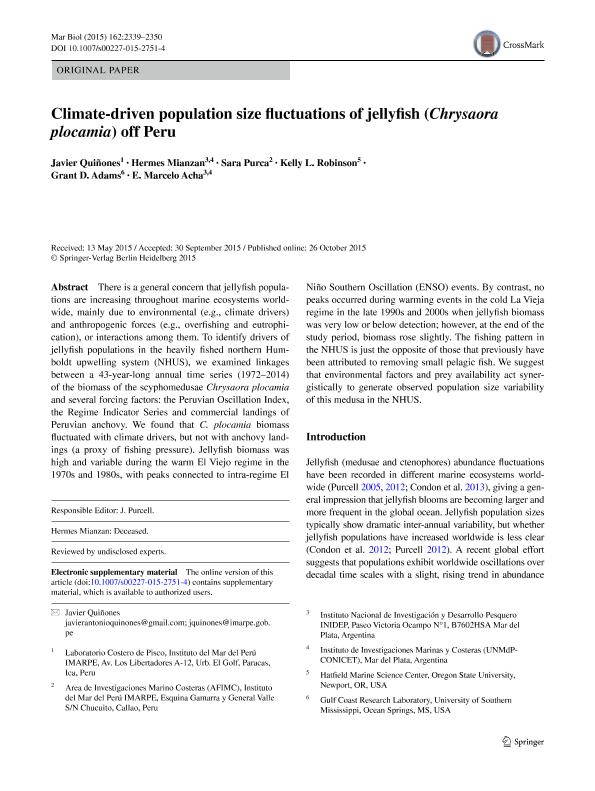Artículo
Climate-driven population size fluctuations of jellyfish (Chrysaora plocamia) off Peru
Quiñones, Javier; Mianzan, Hermes Walter ; Purca, Sara; Robinson, Kelly L.; Adams, Grant D.; Acha, Eduardo Marcelo
; Purca, Sara; Robinson, Kelly L.; Adams, Grant D.; Acha, Eduardo Marcelo
 ; Purca, Sara; Robinson, Kelly L.; Adams, Grant D.; Acha, Eduardo Marcelo
; Purca, Sara; Robinson, Kelly L.; Adams, Grant D.; Acha, Eduardo Marcelo
Fecha de publicación:
12/2015
Editorial:
Springer
Revista:
Marine Biology
ISSN:
0025-3162
Idioma:
Inglés
Tipo de recurso:
Artículo publicado
Clasificación temática:
Resumen
There is a general concern that jellyfish populations are increasing throughout marine ecosystems worldwide, mainly due to environmental (e.g., climate drivers) and anthropogenic forces (e.g., overfishing and eutrophication), or interactions among them. To identify drivers of jellyfish populations in the heavily fished northern Humboldt upwelling system (NHUS), we examined linkages between a 43-year-long annual time series (1972–2014) of the biomass of the scyphomedusae Chrysaora plocamia and several forcing factors: the Peruvian Oscillation Index, the Regime Indicator Series and commercial landings of Peruvian anchovy. We found that C. plocamia biomass fluctuated with climate drivers, but not with anchovy landings (a proxy of fishing pressure). Jellyfish biomass was high and variable during the warm El Viejo regime in the 1970s and 1980s, with peaks connected to intra-regime El Niño Southern Oscillation (ENSO) events. By contrast, no peaks occurred during warming events in the cold La Vieja regime in the late 1990s and 2000s when jellyfish biomass was very low or below detection; however, at the end of the study period, biomass rose slightly. The fishing pattern in the NHUS is just the opposite of those that previously have been attributed to removing small pelagic fish. We suggest that environmental factors and prey availability act synergistically to generate observed population size variability of this medusa in the NHUS.
Archivos asociados
Licencia
Identificadores
Colecciones
Articulos(CCT - MAR DEL PLATA)
Articulos de CTRO.CIENTIFICO TECNOL.CONICET - MAR DEL PLATA
Articulos de CTRO.CIENTIFICO TECNOL.CONICET - MAR DEL PLATA
Articulos(IIMYC)
Articulos de INSTITUTO DE INVESTIGACIONES MARINAS Y COSTERAS
Articulos de INSTITUTO DE INVESTIGACIONES MARINAS Y COSTERAS
Citación
Quiñones, Javier; Mianzan, Hermes Walter; Purca, Sara; Robinson, Kelly L.; Adams, Grant D.; et al.; Climate-driven population size fluctuations of jellyfish (Chrysaora plocamia) off Peru; Springer; Marine Biology; 162; 12; 12-2015; 2339-2350
Compartir
Altmétricas



